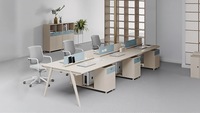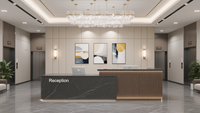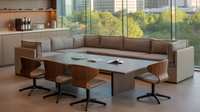As hybrid work continues to shape how we use office space, businesses across Australia are rethinking what makes a workplace truly productive, comfortable, and inspiring. In 2025, office furniture trends go far beyond basic functionality—embracing flexibility, sustainability, and a more human-centric design. Here are six key trends you should watch.

1. Ergonomic Furniture Takes Centre Stage
The link between workplace comfort and employee productivity is stronger than ever. In 2025:
- Adjustable chairs with lumbar support, high-back designs, and breathable mesh materials are in demand;
- Sit-stand desks are moving beyond executive offices into everyday workstations;
- Accessories like footrests, monitor arms, and anti-fatigue mats are increasingly standard.
Ergonomics is now seen as a critical factor in employee wellbeing and long-term productivity. Companies that prioritise comfort and support are investing in a healthier, more efficient workforce.

2. Modular and Adaptable Layouts
With the rise of agile teams and flexible work models, furniture that can be reconfigured quickly is essential:
- Modular desks that transform from collaborative zones to solo workstations;
- Mobile storage units, partitions, and foldable tables enhance agility;
- Complete office “pods” and reconfigurable meeting spaces are trending in dynamic environments.
Modular design allows companies to reconfigure their office without the expense of renovations. It supports agile workflows, team collaboration, and multifunctional spaces—all essential in today’s fast-changing work environment.

3. Nature-Inspired and Sustainable Design
Sustainability continues to influence furniture design, with a growing emphasis on natural textures and eco-conscious materials:
- Recycled wood, bamboo, organic fabrics, and low-VOC finishes are preferred materials;
- Indoor plant walls, greenery zones, and biophilic elements are used to improve air quality and mood;
- Natural light and open space layouts promote wellbeing and reduce stress.
These elements create calm, uplifting environments that reduce stress and boost creativity. For many companies, investing in green design is a reflection of their values and commitment to both people and the planet.

4. Home-Inspired Workspaces (Resimercial Style)
Offices are becoming more relaxed and inviting, drawing inspiration from residential interiors:
- Soft furnishings, textured fabrics, and cozy rugs are common in breakout areas;
- Lounge zones with armchairs, coffee tables, and reading lights encourage informal collaboration;
- Kitchenettes, coffee bars, and wellness corners enhance work-life balance.
This approach helps employees feel more relaxed and connected, improving morale and collaboration. A comfortable workspace is not a distraction—it’s a strategy for better work.

5. Brand-Driven Customisation
Custom-designed furniture is becoming a strategic tool for branding:
- Reception desks in signature colours and logo-integrated tables create a memorable first impression;
- Meeting spaces reflect the company’s personality—whether minimal, creative, or corporate;
- Startups, law firms, and tech companies are tailoring furniture choices to align with their industry image.
Custom furniture makes a strong first impression and reinforces a cohesive brand experience. It’s a simple yet powerful way to communicate professionalism and personality.
6. Tech-Integrated Furniture for Smart Offices
As technology becomes more embedded in work life, furniture is evolving to keep up:
- Desks with built-in charging stations, cable management, and USB ports are now common;
- Smart desks with memory settings, posture tracking, and app control are emerging;
- Conference tables equipped with wireless screen sharing and audio systems streamline meetings.
These innovations streamline work processes and eliminate clutter, making offices more functional and future-ready. For digital-native teams, smart furniture is quickly becoming a non-negotiable.
Final Thoughts: Design That Reflects Culture
In 2025, office furniture is more than just functional—it’s strategic. It reflects how companies value their people, how they tell their story, and how they plan for growth. By embracing these trends, businesses can create workspaces that support wellbeing, express identity, and adapt to whatever the future holds.





